Living in Miami Beach, FL
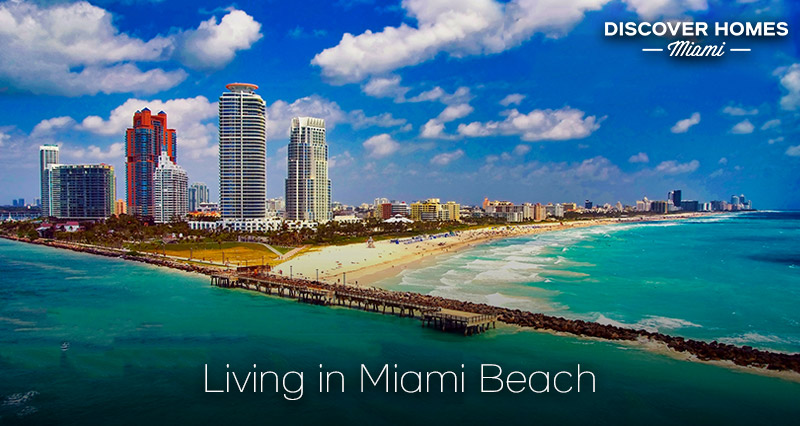
Miami Beach has been one of America’s most famous beach resorts since the early 20th century. This legendary island city conjures up images of white sand beaches, crystalline water, an elegant Art Deco architecture, and is infamous for its glamorous, hedonistic lifestyle. Constantly changing and evolving, Miami Beach’s neighborhoods offer a staggering variety of experiences, and their cultural diversity is unmatched.
Miami Beach draws residents and visitors from every corner of the globe, resulting in a vibrant, eclectic city that defies easy categorization. From the glitz and glamor of South Beach – with its world-famous nightlife, upscale shopping meccas, and second-to-none dining – to relaxed North Beach – with its unique family-owned restaurants and wide, tranquil stretches of sugar-white sand – Miami Beach has something for everyone.
Some of the most exclusive and expensive real estate in the world can be found in South Beach’s glittering luxury condo towers, but there are also low-key residential pockets scattered throughout Miami Beach, offering laid-back living in family-friendly, community-oriented neighborhoods.
Let’s dive into what makes this iconic city such an exciting and rewarding place to live.
Miami Beach in 1920 prior to being developed
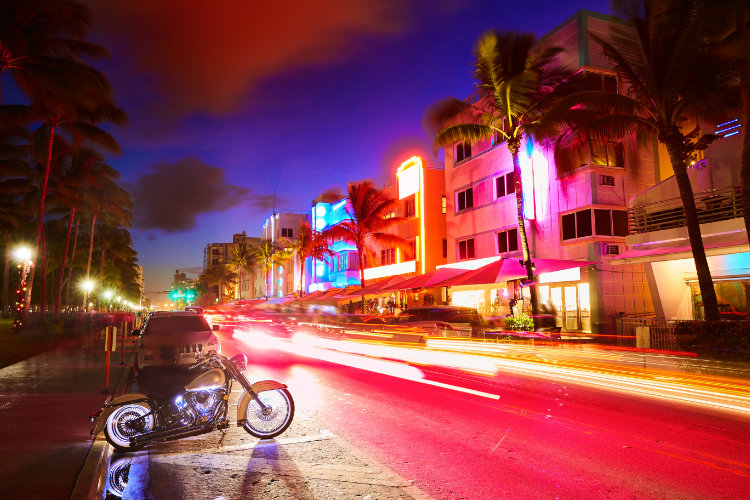 An exposure shot of Ocean Drive in South Beach.
An exposure shot of Ocean Drive in South Beach.
Miami Beach Lifestyle and Culture
South Beach (affectionately referred to as SoBe by locals) and Mid-Beach are among the most pedestrian-friendly neighborhoods in the Miami area. Many locals choose not to own a car, preferring to get around their neighborhood on foot or bike. Part of the attraction of living here is being able to walk or cycle to shopping, dining, and entertainment, and it takes no time at all to get where you want to go.
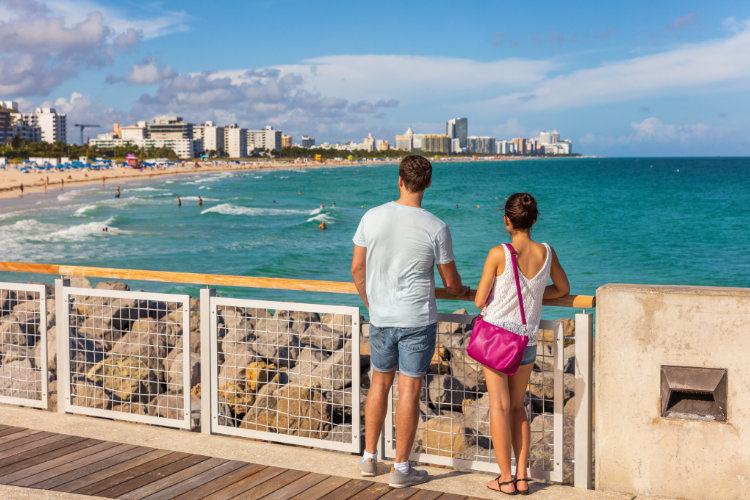 Two tourists on South Pointe Park Pier looking at South Pointe Beach
Two tourists on South Pointe Park Pier looking at South Pointe Beach
Residents enjoy an active lifestyle, and it’s common to see locals walking, jogging, or rollerblading through the neighborhood at all times of the day. The notorious South Florida traffic can be especially bad in Miami Beach’s southern reaches, and parking can be difficult to find. It’s a different story in North Beach, though, where traffic along Collins Avenue is usually fairly light.
Many North Beach residents commute to Downtown Miami, Fort Lauderdale, and Hollywood, and the neighborhood’s convenient location at the ‘Crossroads of South Florida’ means central Miami is only a 30-minute drive. Miami Beach is well-served by public transit, with Miami Metrobus providing regular connections to Miami and the surrounding area. The Miami Beach Trolley is an awesome free service that connects the island neighborhoods. Locals make full use of this hop-on, hop-off service, and it’s always a fun ride.
 A seemingly endless stretch of white sandy beach stretches along Miami Beach’s eastern border.
A seemingly endless stretch of white sandy beach stretches along Miami Beach’s eastern border.
Unsurprisingly, the Miami Beach lifestyle centers around the city’s impossibly beautiful beaches. Fine white sand and clear, aquamarine water are always within easy reach, and South Florida’s incredible year-round weather ensures that every day is a beach day. At Miami Beach’s southern tip, South Pointe Park and Beach provide a relaxing family-friendly environment, and the views from this beautifully landscaped park are nothing short of breathtaking.
Moving further north, the beaches begin to take on a more eclectic and vibrant feel, with Lummus Park and its ‘Muscle Beach’ providing chiseled locals the opportunity to work out and strut their stuff. North of Lincoln Road, the stretches of sand in Mid-Beach are decidedly more stylish, with a ‘see and be seen’ vibe. Chic hotels line the shore, and the latest trends in beachwear are on full display.
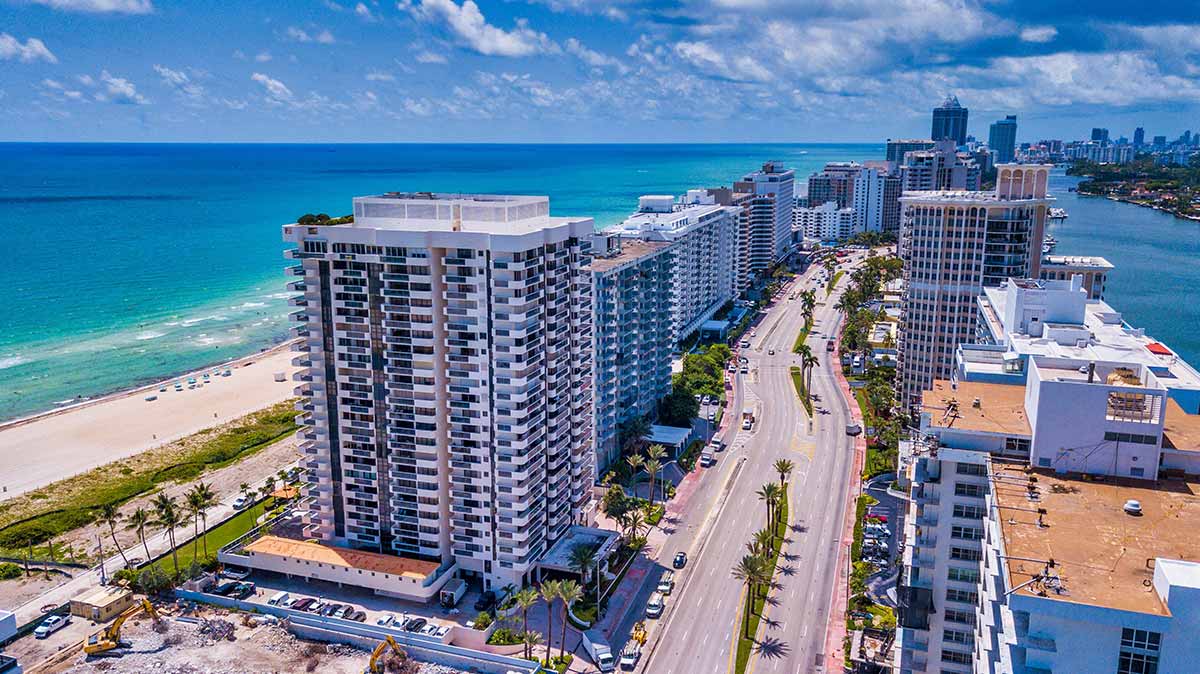 Collins Avenue in North Beach
Collins Avenue in North Beach
North Beach is a different story. Here, the wide, sandy beaches are less crowded, and the vibe is more laid-back. Small, grass-covered dunes line the beach, and local joggers and dog walkers make their way up and down the wooden boardwalk. North Beach Oceanside Park is a gorgeous place for local families to gather on weekends and provides an oasis of tree-shaded trails and enchanting picnic areas.
Miami Beach is home to a mind-boggling array of shopping and dining options, as well as some of the best nightlife on Earth. Lincoln Road, in South Beach, is the most well-known shopping and dining destination in the city. Popular with locals and tourists alike, this incredible pedestrian shopping street is packed with upscale boutiques, cutting-edge restaurants, and trendy coffee joints.
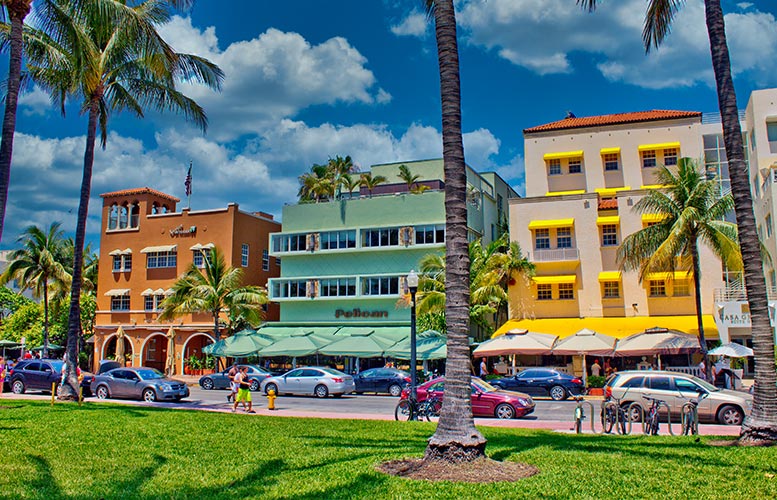 South Beach’s iconic Art Deco architecture.
South Beach’s iconic Art Deco architecture.
Ocean Drive in South Beach is lined with pastel-hued Art-Deco buildings, housing beach boutiques, bars, clubs, and top-notch restaurants. Known as the ‘Capital of Cool’, dozens of upscale fashion designers have outlets here, and fashion trends are often defined on Ocean Drive. Nearby, Washington Avenue is the epicenter of Miami Beach’s nightlife. Home to some of the biggest, most famous clubs in the world, this area is jammed with partiers until the wee hours and beyond.
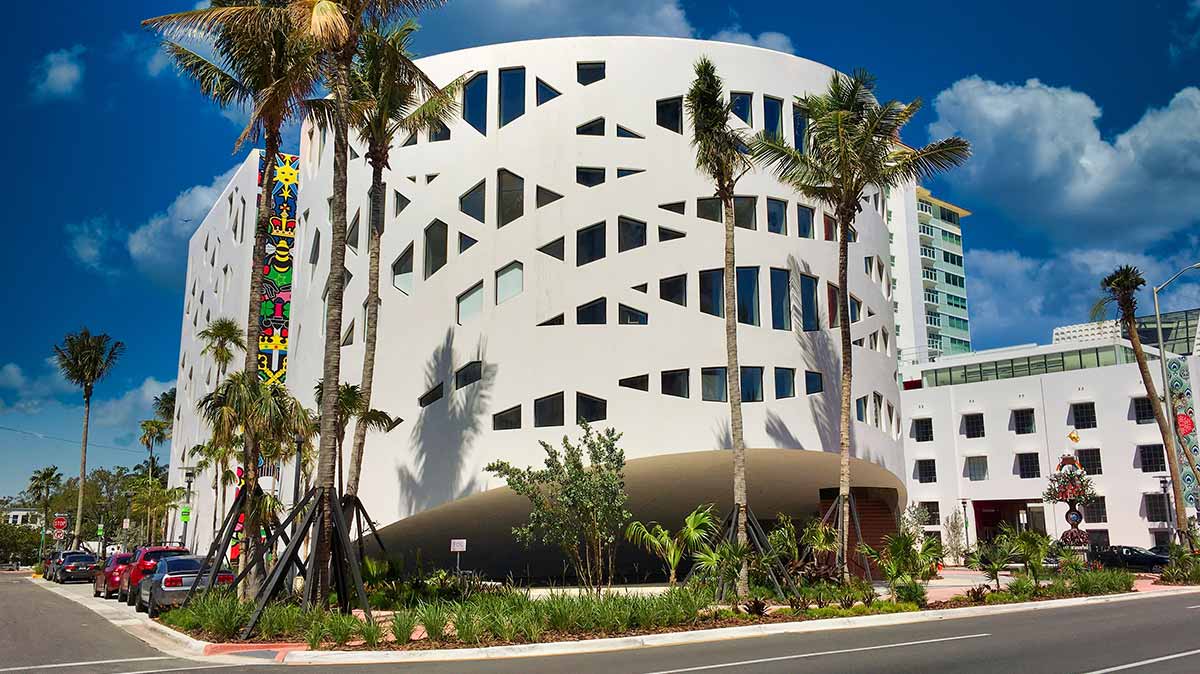 The Faena Forum in Mid-Beach. Credit: Phillip Pessar (modified)
The Faena Forum in Mid-Beach. Credit: Phillip Pessar (modified)
A more chic and refined scene awaits in Mid-Beach, defined by the ultra-stylish Faena District. The Faena Hotel Miami Beach is a luxury paradise, with outrageous decor and outstanding restaurants, led by superstar chefs. The nearby Faena Bazaar shopping center is cutting-edge retail and experiential space, housed in a white Art-Deco building sprinkled with red lips. This fashion mecca is the place to find the latest offerings from both unheard-of local designers and established brands.
Further north, the scene is decidedly more low-key. North Beach has a buzzing local dining scene, defined by locally-owned restaurants serving a diverse selection of cuisines. There’s also a burgeoning craft beer scene in North Beach, and the Brewery District is thriving, thanks to city-driven incentives.
Art and culture are inseparable from the Miami Beach experience. Residents are surrounded by some of the world’s most iconic architecture, as well as museums, galleries, and public art displays. The Art Deco Historic District in South Beach has the nation’s largest concentration of Art Deco buildings, and their whimsical design features, bright colors, and glamorous features are a constant delight.
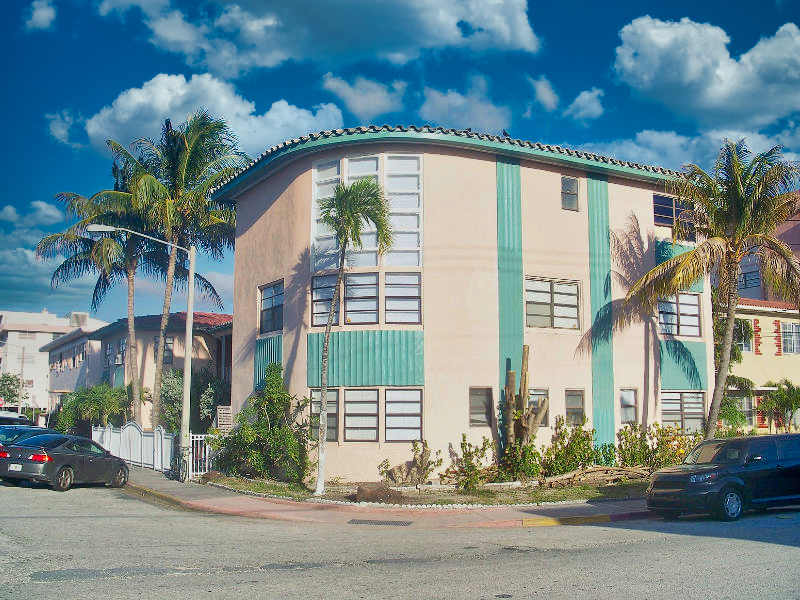 Miami Modern architecture within the North Shore Historic District. Credit: Ebyabe
Miami Modern architecture within the North Shore Historic District. Credit: Ebyabe
In North Beach, Miami Modern (MiMo) architectural delights can be found in the North Shore Historic District, and regular tours are led by the Miami Design Preservation League.
North Beach is also home to the North Beach Bandshell. Since 1961, this beautiful outdoor amphitheater has played host to popular neighborhood events and shows. Now run by Miami Rhythm Foundation, the beloved MiMo structure exemplifies the North Beach neighborhood’s friendly neighborhood feel and plays an important part in bringing the community together.
Miami Beach residents love to celebrate, and there are events and festivals throughout the year. Whether it’s a low-key neighborhood celebration, or a huge South Beach extravaganza, it seems like there’s always something going on in Miami Beach. In laid-back North Beach, many local events are held at the North Beach Bandshell. There’s also a popular Full Moon Drum Circle, as well as regular events in residential neighborhoods.
South Beach is usually where the more high-profile action can be found, and it’s here that annual festivals like Miami Beach Pride and Miami Fashion Week have some of their biggest events. South Beach Wine and Food Festival draws tens of thousands of visitors each year, while Art Basel takes things to a different level. This enormous city-wide event has grown to epic proportions and includes art shows, special VIP events, films, stage shows, and so much more.
Things to Do in Miami Beach
Extreme Sightseeing
There are many ways to go sightseeing around Miami Beach, from open-roof buses to bay cruises. If you’re looking for something a little more adventurous, though, there are a lot of options.
For example, there are extreme sightseeing tours of both Biscayne Bay and the Florida Everglades. Travel around with the wind in your hair in a speed boat or airboat and see the many different sides of Miami Beach, from the natural beauty of the Everglades to the glamour of South Beach and Ocean Drive. There’s even a tour on a pirate ship and another in classic convertibles.
Even if you’re not an adrenaline junky, there are a lot of customizable luxury tours as well. Many of these are private and take patrons around the Miami Beach islands by boat all while providing food and drink. These are ideal for couples looking for a new kind of night out.
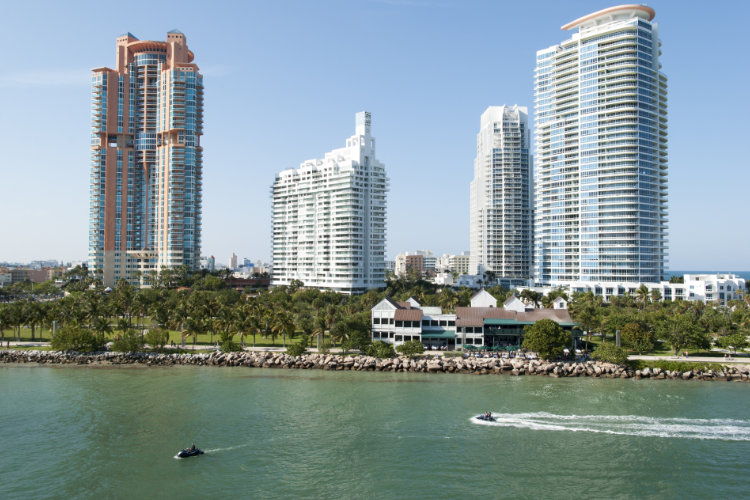 People waterskiing with the South Beach skyline in the background
People waterskiing with the South Beach skyline in the background
Water Sports
Miami Beach is arguably one of the best locations in the country for water sports. No matter your interests, there’s something for you to do out on the sea. No matter your experience level, there’s someone ready to help or teach you.
Popular activities include jet-skiing, wakeboarding, paddleboarding, and parasailing. Kayaking is also big with residents, and there are a number of shops selling and renting equipment. If those aren’t up your alley, regular deep-sea fishing tours set out from Miami Beach. There’s even surfing at the end of the storm season in November when waves are highest. As for the rest of Miami Beach watersports, you can do them year-round.
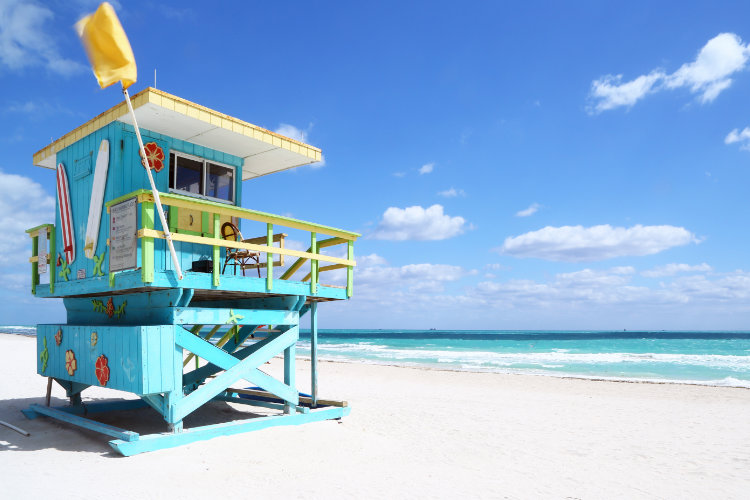 A lifeguard tower in South Beach
A lifeguard tower in South Beach
Beach Bumming
It’s hard to live in or visit Miami Beach and not relax. Sometimes trying to plan an activity-filled day is actually counterproductive, and it’s better to just enjoy a day in the sun. Going to the beach is one of the easiest things to do in Miami Beach. The entire east side of the islands is a public beach, so you’re never more than a 30-minute walk away from the surf and sun.
Now, you could just lie sunbathing from dawn to dusk, but even if you need a little more variety, there’s no reason to leave the beach. There are opportunities for beach sports like volleyball and watersports like kayaking. Plus, the beach is almost always lined with shops and restaurants, so everything you need is right there. Often there are even tent-filled markets set up nearby.
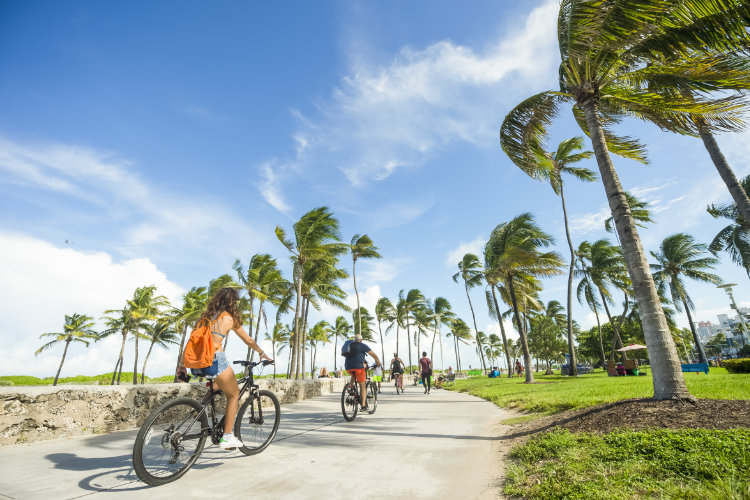 People cycling through Lummus Park in South Beach
People cycling through Lummus Park in South Beach
Rent a Bike
Miami Beach is really into cycling, and it shows both in the infrastructure and the number of cyclists you see pedaling around town. The streets are ready for cycling, and there are a number of trails winding through the parks, historic districts, and beaches.
Many residents own their own bicycles, so there are a lot of shops dedicated to selling, fixing, and maintaining bikes. Of course, you don’t have to buy one. Residents and tourists can also rent bicycles for a day or even just an hour or two, usually at the same shops.
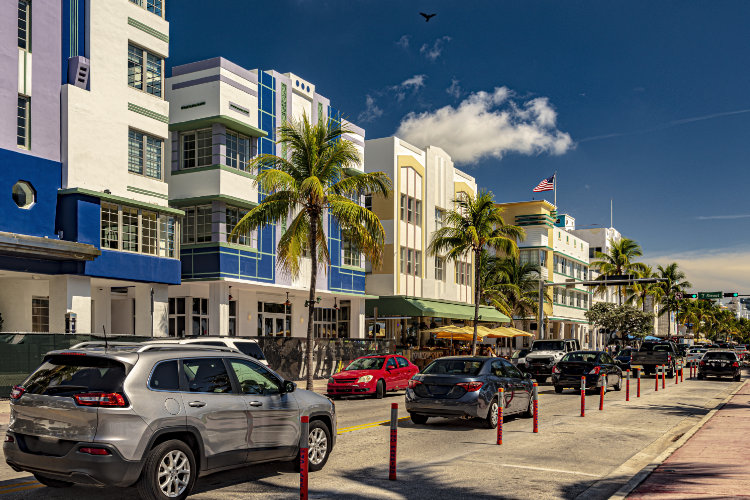 Some of the hotels in the Art Deco District
Some of the hotels in the Art Deco District
The Art Deco District
Art Deco is an architectural style that was popular in the US and Europe in the 1920s-1940s. During this time, it represented modernity and luxury, as well as society’s technological advancements at the hands of industrialism. Above all, it was an optimistic style.
In the South Beach neighborhood of Miami Beach, the city has preserved the largest collection of Art Deco buildings in the world. Many of these lie along Ocean Drive opposite the Atlantic Ocean. The Art Deco District was added to the National Register of Historic Places in 1979.
Simply observing the buildings is enjoyable enough and transports you back to a transformative and energetic period in American history. There’s also a lot to do, though. For example, the famous Italian fashion designer Gianni Versace lived in a mansion right on Ocean Drive called Casa Casuarina that is now a hotel you can visit. You can also take a trip to the Miami Beach Art Deco Museum to learn more about the style and history of the district.
The Bass
The Bass is a contemporary art museum located in Collins Park near the city center. In addition to extensive exhibitions of international art, the museum runs educational programs for people of all ages. These include not only art classes but fitness sessions and food. There are seasonal camps for children as well. Admission is free for Miami Beach residents.
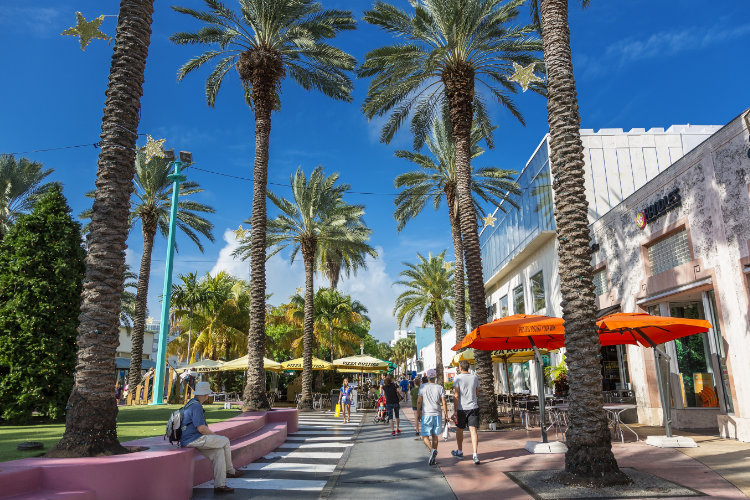 Lincoln Road business district in South Beach
Lincoln Road business district in South Beach
Shopping and Dining in Miami Beach
There are extensive shopping and dining options throughout Miami Beach. Nearly every street features boutique shops and restaurants. While there are a few large commercial centers like Sunset Harbor, most of Miami Beach’s shopping areas are smaller and more walkable.
The most notable shopping and dining area is the Lincoln Road Mall. It begins at the Atlantic Ocean on the east side and crosses nearly the entire island to Alton Road in the west. The promenade is entirely pedestrian and includes dozens of restaurants and local shops as well as large chains like Forever 21 and Zara. There are also theaters and galleries.
As for the restaurant scene in Miami Beach, it’s dominated by Cuban cuisine. These range from inexpensive food trucks and stands to high-end luxury establishments serving authentic Havana fare.
There are plenty of other options, though. To serve the millions of tourists that visit the city each year, Miami Beach has to have a lot of variety, in both cuisine and price. Renowned chefs like Jean-Georges Vongerichten head famous restaurants like the Matador Room, and there are steakhouses, pizzerias, sushi joints, and many, many others.
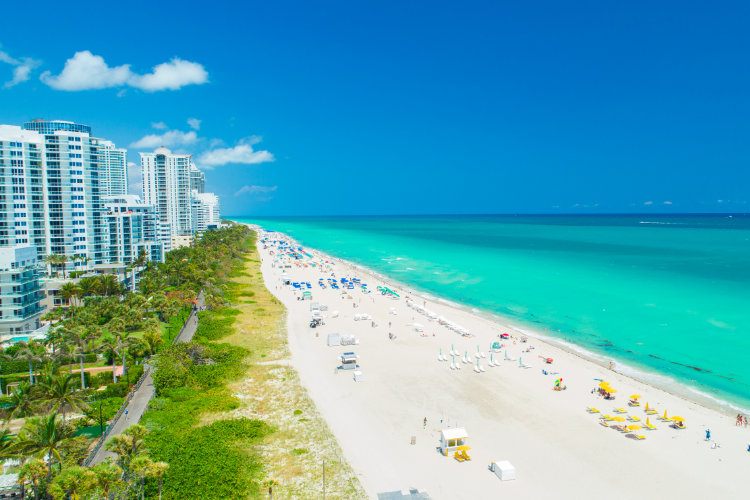 Common weather in Miami Beach
Common weather in Miami Beach
The Climate and Weather in Miami Beach
Miami Beach, along with the rest of southern Florida, is classified as tropical. Its climate is specifically called “tropical monsoon” which reflects a large amount of rainfall Miami Beach receives, even during the dry season.
Still, there is a marked difference between the wet and dry seasons, with May through October experiencing rain and even thunderstorms on a near-daily basis. June is the rainiest month with an average of 8.27 inches of rain and about 15 rainy days. The area is quite humid year-round, usually hovering around 75%.
Of course, being a tropical location, “rainy” means something a little different in Miami Beach. The town receives a lot of rain but in powerful bursts that quickly dissipate, letting the sun return. As a result, Miami Beach is also a very sunny area, with every month of the year averaging more than 200 hours of sunshine and around 70% sunshine per day. You can get soaked in a thunderstorm and go sunbathing on the beach in the same afternoon.
The southern latitude and a large amount of sun are balanced by the city’s location on the Atlantic coast, leading to comfortable, stable temperatures. In fact, Miami Beach is one of only two cities in the entire continental US to have never experienced freezing temperatures.
During January, the coldest month, the average low is 61 degrees, and during August, the hottest month, the average high is 89. This also means the seawater is comfortable for swimming year-round, ranging from 75-86 degrees.
Hurricanes and Flooding
The most dramatic aspect of Miami Beach’s weather is definitely its vulnerability to hurricanes and tropical storms. These powerful storms form in the tropical latitudes of the Atlantic Ocean due to differences in temperature between the air and seawater. These differences are greatest at the end of the summer in August and September. Miami Beach has been hit by a number of major hurricanes over the last century, which has made hurricane preparedness a part of the city’s culture.
Additionally, Miami Beach is susceptible to flooding since it’s located on a group of low-lying islands. From September-November, Miami Beach experiences what the residents call “King Tide,” the highest tide of the year. This can sometimes flood the streets, but the city has been developing increasingly technological and ecological methods to deal with these floods like wetland conservation areas and elevated roads and sidewalks.
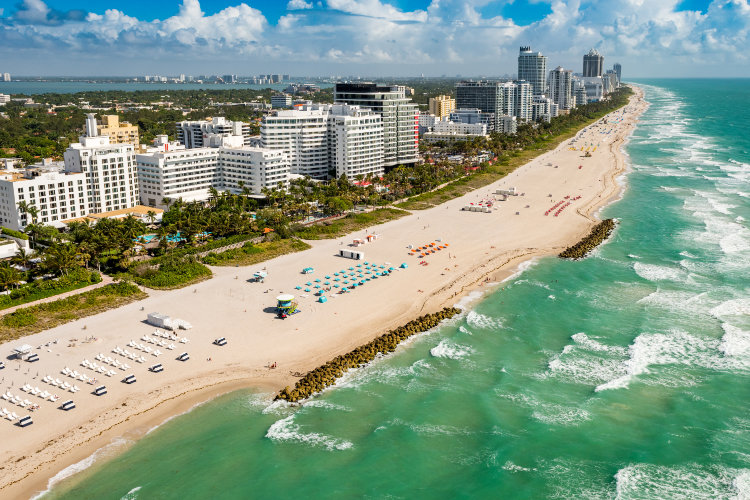 The long stretch of beach along Miami Beach’s eastern border
The long stretch of beach along Miami Beach’s eastern border
Parks and Recreation in Miami Beach
As you might expect, parks and recreation in Miami Beach is dominated by the beach. The entire eastern border of the city is a public beach along the Atlantic Ocean, all full of recreational activities like volleyball and trails as well as lifeguard posts and seating. From north to south, these beaches include:
- Full Moon Beach: This beach is known for being a bit less crowded due to fewer resort complexes in the northern part of the city.
- North Shore Park Beach: Also a little farther from the main resort areas, this length of beach is less crowded and filled with natural beauty and plant life. It’s dog-friendly (and therefore sometimes called the “bark beach”) and popular with residents
- Ocean Terrace Public Beach: This public area is very popular for kite surfing. There are also chairs with shade umbrellas you can rent for a small fee.
- North Beach: North Beach is easily accessible from hotels and resorts but still not as crowded as the southern beaches.
- Miami Beach: The main beach of the city and the longest, Miami Beach has easy accessibility and plenty of amenities including parking and playgrounds. On top of its soft white sand, there is a natural beauty with trees to enjoy.
- South Beach: South Beach, which lies across from the Art Deco Historic District and many hotels and resorts, is easily the most popular beach in the city. Here you’ll find tourists and residents of all ages and nationalities enjoying the sun and watersports.
There’s more to Miami Beach parks and recreation than just the beach, though. In fact, the city has over 40 parks and facilities. The biggest and most accessible include:
- Lummus Park: This park consists of over 26 acres along Ocean Drive with access to South Beach and the Art Deco Historic District. It has pavilions and picnic areas, playgrounds, walking trails, volleyball courts, and even two outdoor fitness centers sometimes called “muscle beach.”
- South Pointe Park: At the southern tip of Miami Beach, this park has trails and playgrounds as well as a centrally located restaurant. The biggest draw, though, is the access to South Pointe Park Pier that provides space for cycling and skateboarding in addition to its ocean views.
- Flamingo Park: Flamingo Park covers 36.53 acres of the South Beach neighborhood and is the go-to location for organized sports. There are football and soccer fields, tennis courts, and even the Flamingo Aquatic Center.
- North Shore Park & Youth Center: This center provides recreational opportunities for youth and family. In addition to fields, a gymnasium, and tennis courts, the center features a computer lab, dance room, and auditorium. Children, adults, and seniors are all welcome to take part in various programs put on by the center.
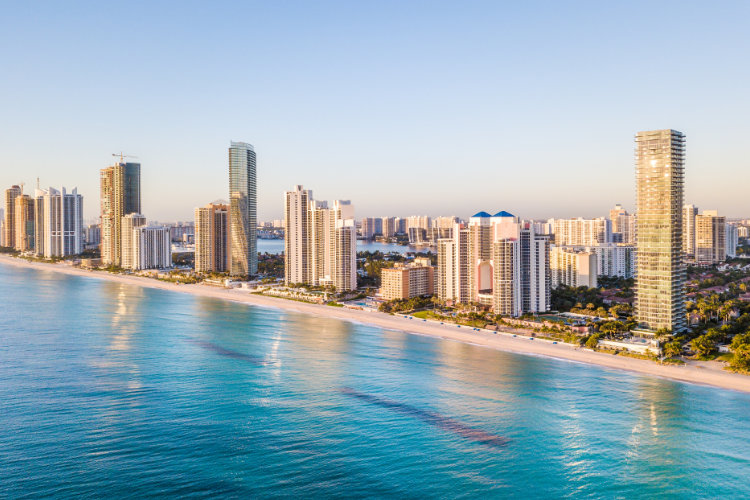 High-rise waterfront condos in Miami Beach
High-rise waterfront condos in Miami Beach
Miami Beach Real Estate
As one of the most affluent areas in the United States, real estate in Miami Beach is highly sought after. As a set of small islands, land in Miami Beach is at a premium. Consequently, Miami Beach real estate primarily consists of condos. These vary from units in brand new high-rise condo buildings to apartments in smaller, historic Art Deco buildings.
The main draw of Miami Beach is the beach itself, so oceanfront properties are in the highest demand. For the few single-family homes in the city, it’s common for them to lie on long, narrow plots so that they have beach access at one end. Condo buildings tend to be taller along the coast as well, providing for more ocean views.
Due to the small amount of land, entirely secluded single-family homes are rare. That said, landscaping is a major part of Miami Beach real estate, and people manage to tuck away their houses in their own personal jungle of palm trees and ferns even if lot sizes are small.
There are several small islands off of the main Miami Beach island that feature mega-mansions inhabited by the extremely wealthy. Two examples are Star Island and La Gorce.

